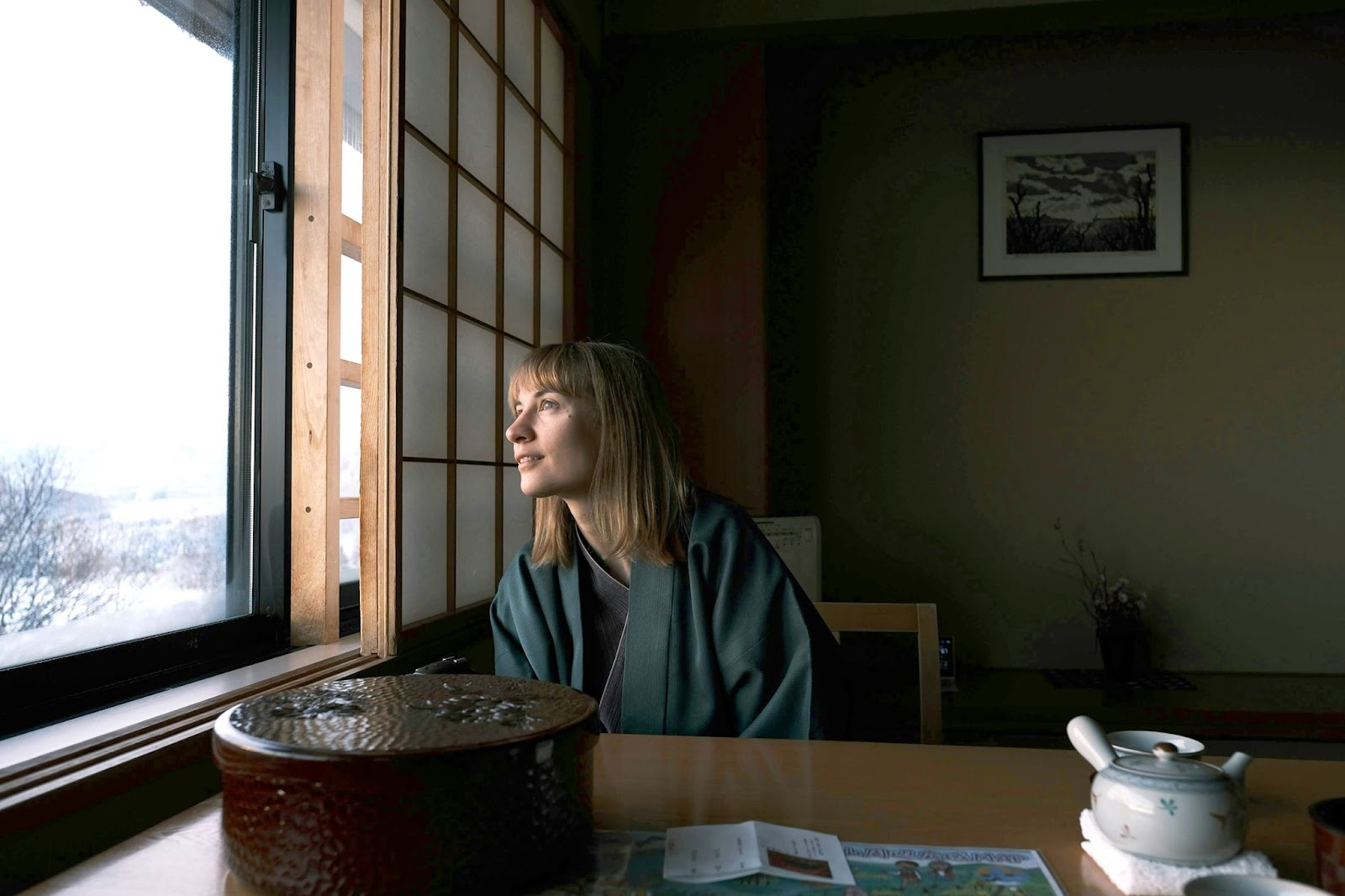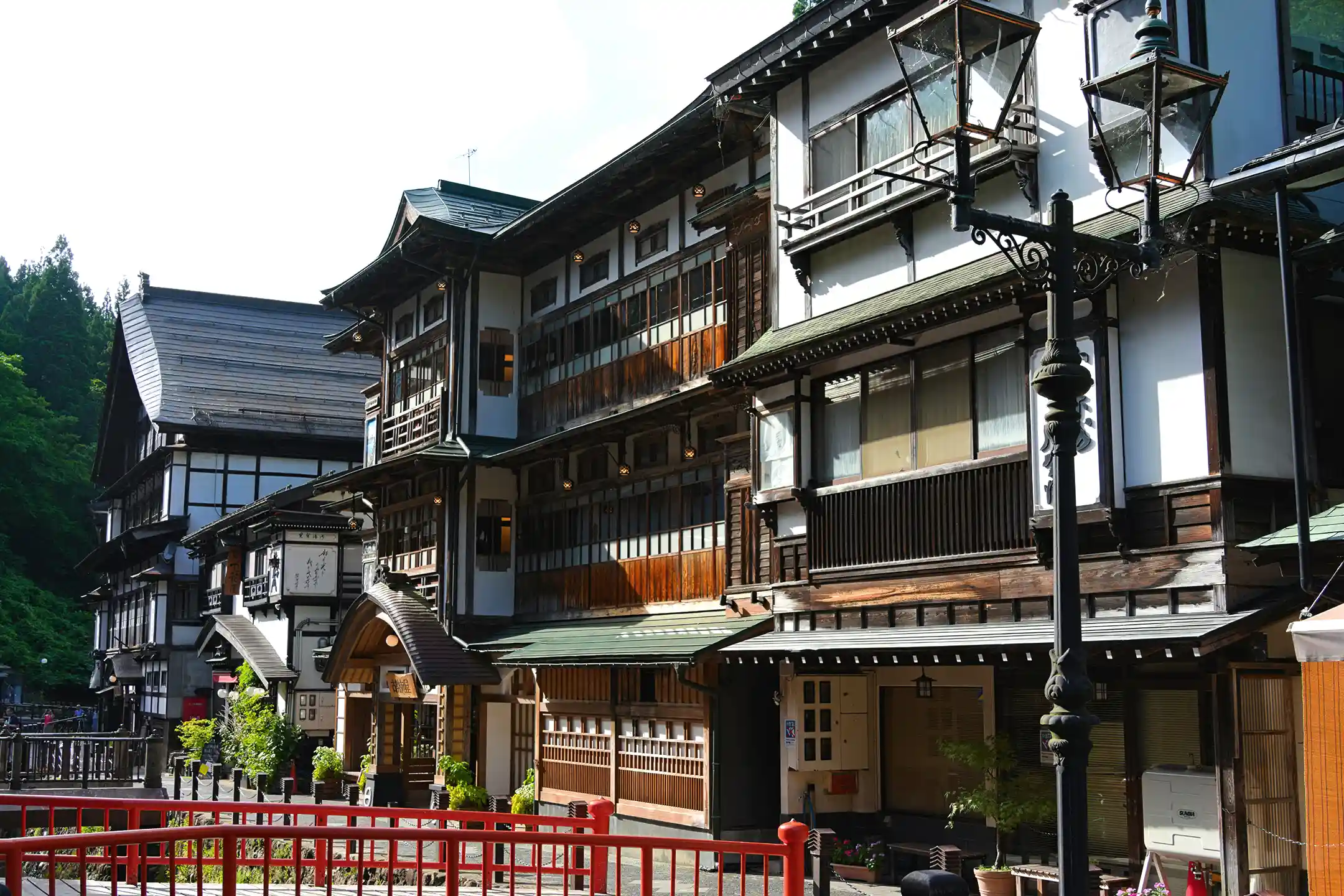Milestone occasions like wedding anniversaries or birthdays deserve a setting that feels truly special, and a traditional Japanese ryokan offers an incomparable stage. Time spent in these harmonious spaces gives you private tranquility away from the bustle, illuminated by attentive omotenashi—hospitality delivered with care at every turn.
Even if you’re not familiar with Japanese culture, you can relax. From tatami‑mat rooms and yukata robes to intimate touches made just for two, this article walks you through it all in clear, friendly terms. Let’s explore the allure of a ryokan stay with all five senses—and discover how it can make your celebration unforgettable.
The Essence of a Ryokan and Omotenashi
A ryokan is more than a place to sleep; it’s a doorway into Japan’s distinctive cultural life. The spirit of omotenashi—welcoming you wholeheartedly—permeates every detail. To start, let’s clarify how a ryokan differs from a hotel.

Key Differences Between Ryokan and Hotels|Guest Rooms, Dining, and Service Flow
A ryokan’s defining characteristics fall into three broad areas.
Guest Rooms: While Western‑style hotels primarily offer bedrooms with beds, ryokan guest rooms are tatami‑mat washitsu (traditional Japanese rooms). At many traditional ryokan, futons are laid out on the tatami at night. You remove your shoes and unwind in a space framed by shoji screens and a tokonoma alcove, designed for unhurried comfort(*1).
Dining: Dinner and breakfast are typically included in your stay, with seasonal kaiseki cuisine that highlights local ingredients. Dinner is often served in your room or a private dining room, with an attendant (nakai) bringing each course as it’s prepared(*1). Whereas other lodgings might emphasize buffets or a wide variety of dishes, ryokan focus on presenting regional specialties at their very best(*2).
Service Flow: Hotels tend to divide tasks among departments; at a ryokan, a dedicated attendant (nakai) looks after your room and needs throughout your stay. From a welcome with matcha and sweets at check‑in, to a guided walk‑through of the property, meal service, and evening futon preparation, you receive finely tuned, individualized attention(*1).
Three Reasons Ryokan Are Chosen for Anniversaries
Privacy: Small‑scale ryokan and in‑room dining let you relax without worrying about others. Because you’ll have fewer encounters with other guests, it’s easy to slip into a world for just the two of you and savor time that feels intimately your own.
Flexible Personalization: Ryokan aim to understand each guest’s preferences and provide services tailored to you(*3). The staff‑guest distance is close, so it’s simple to share requests—from allergy accommodations to surprise moments.
Photogenic Japanese Design: Tatami, the gentle glow of lanterns, fresh seasonal flowers, and gardens—ryokan are filled with scenes that read as unmistakably Japanese. Stroll the grounds in traditional attire or capture a serene moment in your washitsu; those images become keepsakes that hold their beauty for years.
How to Choose by Ryokan Type
Cuisine‑First or Hot‑Spring‑First: If your priority is dining, consider a small ryotei ryokan (culinary‑focused inn). If you’re dreaming of hot springs, look for an onsen ryokan with a large bath or a guest room that has its own open‑air bath.

Urban or Countryside: Urban ryokan make sightseeing convenient. In contrast, ryokan in rural or nature‑rich settings offer quiet surroundings where you can feel the seasons unfold. Choose a modern city base—or a hideaway that delivers a complete change of pace.
Scale (Number of Rooms): Large ryokan often have abundant facilities but may offer more standardized service. High‑end ryokan with fewer rooms tend to deliver denser omotenashi and a more distinctive stay. If uninterrupted time together matters most, consider a retreat with only a few dozen rooms—or fewer.
Tips for Choosing and Booking a Ryokan Without Missteps
To make your special day truly exceptional, smart selection and smooth booking matter. From budget and timing to reservation methods, advance notices, and day‑of prep, here are the practical keys to success.
Budgeting and Best Seasons
Ryokan rates vary by season and day of the week. Peak periods—spring and autumn travel seasons or long holidays—bring higher prices and tighter availability. Off‑peak times, like mid‑winter or the rainy season, can be excellent value. Weekends (especially Saturdays) are usually pricier than weekdays; if you’re flexible about celebrating a day or two before/after the exact date, you may secure better terms.
Open‑air‑bath suites and special plans cost more, but they deliver added privacy and perks. Balance the premium against the experience you want.

When to Book Direct vs. via OTAs
You can book directly via the official website or phone, or through OTAs like Rakuten Travel and Booking.com. Direct booking makes it easy to convey requests and sometimes unlocks website‑only benefits. If price and availability are similar, booking direct is often your best bet.
On the other hand, OTAs let you compare many properties at once and see real‑time availability and pricing. Even if direct channels are full, an OTA may still show an opening. Reviews can help too—focus on comments from anniversary stays and read low ratings carefully to judge whether a property fits you.
What to Confirm in Advance: English Support, Dietary Needs, Tattoos
English Support: Check the official site or reviews to confirm English signage and staff capabilities. Many luxury ryokan have English‑speaking staff; if unsure, send a quick email and they’ll let you know.
Dietary Restrictions: For vegetarian needs, allergies, or religious considerations, inform the ryokan at booking or a few days before arrival. Most will accommodate as much as possible(*2)—but because of ingredient sourcing and menu prep, the earlier the notice, the better.
Tattoos: Policies vary. Some baths traditionally restrict tattoos, but more properties now respond case by case—offering cover stickers for small tattoos or suggesting private‑bath time slots(*3). If you’re concerned, ask before booking and confirm an option that ensures a comfortable soak for you both.
Pre‑Arrival Checklist
Arrival Time: Dinner typically starts around 18:00–19:00. Exact times vary by ryokan, so confirm in advance—and if you’re running late, call. Arriving too late can mean missing dinner service altogether(*1).
Surprise Prep: Want flowers or a cake to appear during dinner? Many ryokan offer these as paid options. Ask at booking so everything is set discreetly.
Allergy Final Check: Even if you’ve noted items in your reservation, mention any “can’t eat/dislike” items again at check‑in for complete peace of mind.
Photo Etiquette: Be mindful of other guests’ privacy indoors, and never take photos in the large communal baths. Avoid flash and loud voices; protect the serene atmosphere.
Transport: Driving? Set your navigation ahead of time. Using public transport? Confirm shuttle availability and directions from the nearest station. Reserve pick‑ups if needed.
Anniversary Touches at a Ryokan|Designing Private Surprises
To make your celebration even more memorable, lean into the private, ryokan‑specific touches. Plan thoughtful surprises that feel elegant and heartfelt—perfect for time that belongs to just the two of you.
Creating Private Dining
Dinner at a ryokan is often the highlight of the occasion. Choose in‑room dining or a private dining room so you can relax without distraction. If you mention it in advance, staff can prepare champagne or local sake for your toast. Dim the lights and let lanterns glow softly—the ambiance becomes instantly romantic. Linger over a quiet toast and set the tone for a special night.
Classic Surprises—and Advanced Ideas
Ryokan can help you stage everything from tried‑and‑true gestures to more elaborate moments. The classics are flowers and cake: by requesting ahead, you can have a birthday cake or message dessert presented as a surprise during dinner, or have a bouquet waiting in your room(*1).
Slip a simple message card to the staff and ask them to deliver it at the table. For an advanced touch, consider tucking a surprise message into the printed menu, or arranging a short private use of the garden to propose under the night sky. Ryokan staff love to help celebrate—so don’t hesitate to talk through your ideas.
Designing “Just Us” Time in the Baths
If you both love hot springs, a private bath together can become a cherished memory. Check for kashikiri (private‑use) baths and reserve a time slot in advance. With no interruptions, you’ll savor the onsen entirely on your own(*2).
A guest room with an open‑air bath lets you slip in whenever you like and unwind right in your room afterward. Add a little ritual—sharing milk or a beer after your soak—and the before‑and‑after moments become part of the memory.

Composing Photographs That Shine with Poise
Capture images that feel uniquely ryokan. The warm glow of lanterns and andon lights lends a refined, welcoming tone. In the garden, shoot at dusk or against softly lit scenery for romantic silhouettes.
Always avoid including other guests, and remember that photography is prohibited inside communal baths. Keep flash and voices low to protect the calm.
Etiquette and Peace‑of‑Mind for Your Ryokan Stay
If it’s your first ryokan, a few basics will help you feel at home. When you understand the cultural context—and take advantage of multilingual support—you can relax and enjoy every moment.
From Check‑In Onward
At the entrance, remove your shoes. If there’s an attendant for footwear, hand over your shoes and change into slippers before stepping inside. After check‑in, a staff attendant (nakai) will guide you to your room and may welcome you with tea and a traditional sweet(*1).
Try on the yukata provided in your room—remember to close it left‑over‑right (left collar on top). After dinner, a staff member will come to lay out your futons(*1); you don’t need to prepare bedding yourself. When interacting with staff, a warm smile and a simple “please” and “thank you” are perfectly polite.
Bathing Etiquette for Onsen and Large Communal Baths
There are a few Japan‑specific bath customs. In the changing area, undress and wash thoroughly before entering the bath. Use the shower or pour warm water over your body to rinse away sweat and soap before soaking(*2). Do not put towels in the water(*2).
Tie back long hair so it doesn’t dip into the bath. Keep voices low and enjoy the quiet if others are present. Photography is prohibited(*2).
When you finish, dry off well before returning to the changing room. Some ryokan restrict tattoos in large communal baths; if this applies to you, ask about private‑bath options in advance.
Working with the Concierge
The more you share ahead of time, the better the ryokan can care for you. When booking—or before you arrive—feel free to note disliked items or allergies, your celebration details, and any surprise plans. Staff will accommodate as much as they can.
If anything comes up during your stay, speak with your attendant or the front desk right away. If you’re nervous about English, writing notes or using a translation app works well. Partner with the team, and your stay will be smooth, safe, and memorable.
Cuisine That Creates Lasting Memories|Kaiseki, Pairings, and Breakfast
Meals at a ryokan are edible portraits of local climate and season. Because you experience them with all five senses, they can etch your anniversary more deeply into memory.
Kaiseki Basics and How to Enjoy It
Dinner is a multi‑course kaiseki progression—from the opening bite to a gentle dessert—telling a seasonal story. Each dish features ingredients at their peak, presented with craftsmanship that turns plating into art.
Savor the seasonal colors in the opening course, breathe in the broth’s aroma in the soup, and enjoy the shifting flavors of sashimi and grilled courses as they arrive. Notice the tableware, too: traditional craft pieces elevate each dish.
The key is to take your time. If your attendant explains the menu, listen for stories about ingredients and techniques, and share impressions with your partner—you’ll remember the meal even more vividly. Ryokan menus often showcase local specialties and seasonal produce(*1). If a new ingredient or flavor surprises you, say it out loud to each other and celebrate that discovery.

Designing Drink Pairings
Drinks are an essential part of your celebration table. Some ryokan have sommeliers or kikizake‑shi (sake professionals) who recommend local sake or wine to match your courses.
With sake, you might try a bright ginjo with appetizers and a richer junmai with meat—tasting small pours in sequence to unlock new harmonies. Many ryokan now offer wine pairings as well; toasting with a regional wine or champagne is lovely. Recently, non‑alcoholic pairing courses have begun to appear(*2).
Even if you don’t drink alcohol, thoughtful pairings can enhance the meal. From the first toast to the closing cup—dessert tea or a digestif—curate the flow and your dining experience will feel complete. When in doubt, ask the staff for a glass that suits the dish in front of you.
Personalizing Your Meal
Ryokan cuisine reflects a desire to honor each guest. Many properties genuinely strive to meet dietary requests—whether allergies, religious restrictions, or personal dislikes—when informed at booking or at check‑in(*3).
Depending on the menu, some requests may not be possible; advance communication is vital. You can often ask for smaller portions, or request celebratory touches like sea bream or red rice for special occasions.
Breakfast is typically Japanese‑style, but some ryokan can switch to Western or lighter options on request. The care that goes into tailoring meals is part of the ryokan spirit. Share your preferences freely and create the best culinary experience for both of you.
Case Study|Ryotei‑Style Ryokan: Asadaya Ryokan
Located in Kanazawa, the long‑established ryotei ryokan Asadaya Ryokan—often searched as “asadaya ryokan”—traces its origin to Asadaya (a courier business) founded in 1659 and opened as a hatago (inn) in 1867. It’s renowned for more than 350 years of history and hospitality polished down to the smallest detail(*1).
With only three rooms, the cuisine holds one Michelin star, and the inn itself is rated as exceptionally comfortable and captivating(*1). Quiet, refined spaces, beautiful pocket gardens, and seasonal décor deliver a ryotei‑ryokan experience that truly stands apart.
The Value of the Asadaya Experience
Step through the entrance and you’re in a different world of calm. Sprinkled stone paths, a custom noren curtain changed seasonally, and a sukiya‑style interior where Kaga craftwork appears in subtle ways—all set the tone.
Each guest room includes its own small garden; the view from the hiroen (veranda) soothes the mind. You’ll be welcomed at check‑in with matcha and wagashi, and throughout your stay you’ll taste Kanazawa’s culture and seasons with all your senses.
Why It’s Ideal for Anniversaries
Asadaya is chosen for celebrations because it excels at personalization and privacy. With so few rooms, service for each couple is exceptionally attentive.
Past stays have shown that the team keeps a guest card noting preferences—from the ideal pillow firmness to favorite drinks—and quietly prepares for your return(*2).
Even on a first visit, if you mention your anniversary at booking, they’ll respond flexibly—arranging a surprise cake at dinner, for instance. All parties dine in private rooms, so you won’t encounter other guests during your meal. Your special time stays yours.
Booking and Room Selection Tips
Because there are only three rooms (two Japanese rooms and one Western‑style suite), start booking six months or more in advance. The purely Japanese rooms “Takao” and “Furō” feature tatami and private gardens for a serene mood. The suite “Tsuzumi” separates bedroom and living room, includes beds and a mist sauna, and suits guests who prioritize comfort.
Direct booking via the official website (English available) is the safest route and the easiest way to share requests. Note allergies and any surprise plans at the time of reservation for a seamless experience.
Date Routes to Weave Around Your Stay
Pair your ryokan time with a little Kanazawa sightseeing. Right outside Asadaya, Ōmichō Market offers fresh seafood lunches and casual bites.
Within walking distance, Kenrokuen Garden is gorgeous in every season—perfect for a leisurely stroll. The Higashi Chaya District, a five‑minute drive away, preserves Edo‑period streetscapes; pause at a Japanese‑style café before heading back. You’ll carry Kanazawa’s charm with you as you return to the ryokan.

Asadaya Ryokan—Essential Information
Location: Kanazawa, Ishikawa Prefecture (near Ōmichō Market). About 5 minutes by car from JR Kanazawa Station.
Inquiries: See the official website (English page available). English name: Asadaya Ryokan (often searched as “asadaya ryokan”).
Rooms: 3 total. All non‑smoking; Wi‑Fi available.
Rates: From ¥50,000 per person for one night with two meals (varies by season and plan).
Reservations: Book directly via the official site or by phone (major credit cards accepted). Early booking recommended.
In Closing
A ryokan fills your anniversary with moving, out‑of‑the‑ordinary moments—and creates memories you’ll carry for life. Refined hospitality, seasonal beauty, exquisite cuisine and hot springs, and above all, heartfelt service deepen your bond in ways you’ll feel long after you return home. Use the pointers in this guide, and let an exceptional ryokan stay color your special day in the most extraordinary way.
Author Bio

Natsumi Ikeshita
Experienced in B2B SaaS marketing and “omotenashi,” Natsumi directs media operations with a focus on hospitality and cultural storytelling. Her global experience and marketing skills bring fresh value to Bespoke Discovery’s content.





